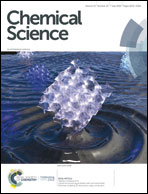Gyroid structured aqua-sheets with sub-nanometer thickness enabling 3D fast proton relay conduction†
Abstract
A polymerizable amphiphile having two zwitterionic head-groups has been designed. This compound co-organizes with an acid, bis(trifluoromethanesulfonyl)imide (HTf2N), into a gyroid bicontinuous cubic liquid-crystalline phase. In situ polymerization of this phase has been successfully achieved by UV irradiation in the presence of a photoinitiator, yielding a self-standing gyroid-nanostructured polymer film. When the polymer film is placed under different relative humidity conditions or in water, it absorbs water owing to the strong hydration ability of the zwitterionic parts. It has been found that the polymer film preserves the gyroid nanostructure after the water absorption. Based on reconstructed electron density maps, it is assumed that the absorbed water molecules form a 3D continuous network along the gyroid minimal surface, which satisfies several key conditions for inducing fast proton conduction. As expected, such hydrated films show high ionic conductivities in the order of 10−1 S cm−1 when the water content of the film reaches 15.6 wt% at RH = 90%. The high conductivity is attributed to the induction of the Grotthuss mechanism, that is, proton conduction via the hydrogen-bonding network of the incorporated water molecules.

- This article is part of the themed collections: 2019 Chemical Science HOT Article Collection and Functional Organic Materials Symposium Collection


 Please wait while we load your content...
Please wait while we load your content...